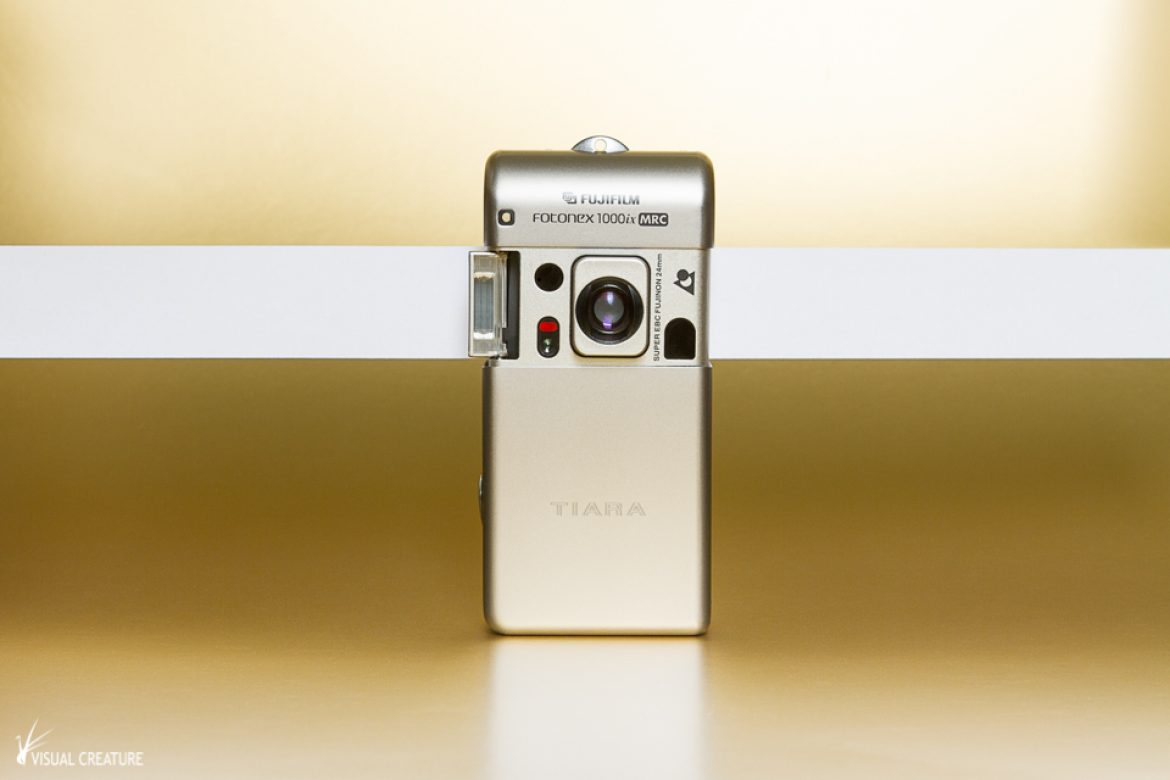My love for analog film photography
I just published a serie of creative product stills titled ‘The Analog Film Camera‘. It’s actually a serie I shot in 2012. The idea came from presenting old equipment in a modern and edgy way. I started out with 80s equipments and toys, like the original Nintendo Game Boy or the Sony Walkman.
Not soon after, I settled on the analog film camera. Simply because I already had a little collection of different types of cameras already, like the gold metallic coated APS (Advanced Photo System) compact by Fuji, known as the Fotonex 1000ix MRC Endeavor / EPION 1000 Titanium. This camera was a prize my dad won and he gave it to me. This could very well be my first camera I ever owned. The format was a short-lived, but interesting format. The film came in cartridges that could actually be pulled out of the camera at any time and put back in again if needed. Its key features were the three different aspect ratios you could choose from:
- H for “High Definition”
(30.2 × 16.7 mm; aspect ratio 16:9) - C for “Classic”
(25.1 × 16.7 mm; aspect ratio 3:2) - P for “Panoramic”
(30.2 × 9.5 mm; aspect ratio 3:1)
Other cameras I had in my possession were the Polaroid 600 Instant camera and the Mamiya 645 Medium Format SLR. Soon thereafter I collected the Canon T-90 35 mm SLR, the 35 Fish Eye Lomo and the 35 mm Disposable (the cheapest one!). The other cameras were borrowed.
Photographic Design
Since I was photographing analog film cameras, I thought I’d create a design using real-world material instead of creating the final image digitally. So I used different coloured cardboards and papers as the background to create different shapes and shadows that would fit with the design of the camera perfectly. Not every single one is as strong, but as a serie, it certainly looks amazing.
Exploring analog film photography
During these few weeks, my interest in analog film cameras was piqued. I started playing with the APS compact again (so sexy!). Unfortunately, I didn’t have any spare cartridges any more. I always wanted to master the art of photography and being raised with digital photography, I always felt it was kind of cheating. The camera already does so much for the user, that without mastering it, you would likely get a decent shot out of it. Of course, it still takes a lot of skill and experience to get any amazing, but it sure is a lot easier than it used to be.
Hence my interest in getting my hands on one. So were better to start than a 35 mm SLR, the form factor that is closest to the digital SLRs I already use. The Canon T90 is one of the most modern analog 35 SLR cameras produced. It has TTL, a modern design and many automated functions that you still see in today’s cameras. This camera is an absolute joy to work with and the manual focusing forced me to take a good look at the subject before pushing the button. Still, it all felt a bit too familiar and the challenge just wasn’t quite there.
I moved on to explore the medium format. Bigger films, more room to play with the depth of field and best of all, a different form factor. Somewhere in 2005/2006 a friend and I bought the Mamiya 645, but since we never took the time for it, we never really got to test drive it. The first time you look into the viewfinder is truly amazing. That quickly was unlike anything I’ve experienced before. Before I knew it, I was exploring different 6×4.5, the 6×6, the 6×7 and the 6×9 formats.
The love for analog film photography
In late 2012 I acquired a complete Mamiya RB67 set. I see it as the bigger brother of the Mamiya 645. Bigger, bulkier and heavier, but also more flexible. I knew you could attach a Polaroid back to it. So I got that one as well and that’s where the real magic happened to me. The whole process of looking and composing, then taking the picture, pulling it out and waiting anxiously as those minutes pass by. Then, finally it’s the moment to peel away the back of the instant film. Wow. Just wow. So beautiful.
That’s when I knew I was in love with analog film photography. It’s the joy of creating that perfect image that is unique. Because every reproduction of that film you just shot, just isn’t the same one. As for a digital photo, every copy consists exactly the same ones and zeroes and in the same order as the original file.
Continuing my journey
Nowadays, I photograph both in digital as well as in film. The main difference is that I use a digital camera for commercial work. Simply because clients expect a certain speed and specific type of image quality that is associated with modern day photography. Yet, my best work is mostly shot on film. Because it allows me to better express myself as an artist.
It allows me to photograph more loosely. Less by the rules and more intuitively. I absolutely love the 6×7 and 6×9 formats and I’m hoping to get accustomed with large format photography one day as well. It’s not all big formats though, since my next target is the half-frame Olympus Pen camera. It’s a perfect camera for street photography and the half-frame format allows for some creative photography, like shooting diptych frames. That camera should be arriving soon, so I will write about it very soon as well.







